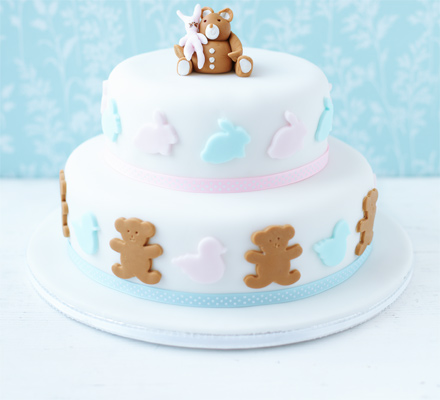Teddy Christening cake
Make an impressive Christening or 1st birthday cake using these simple techniques and our step-by-step photographs
- Several hours depending on ability
- Serves 50
- Easy
Nutrition per serving
-
kcal 0
-
fat 0g
-
saturates 0g
-
carbs 0g
-
sugars 0g
-
fibre 0g
-
protein 0g
-
salt 0g
Ingredients
- 1 x 15cm light fruitcake (see related recipes)
- 1 x 23cm zingy lemon cake (see related recipes)
- icing sugar, for dusting
- 200g smooth apricot jam
- 500g pack marzipan
- 500g white ready-to-roll icing 'regal ice' (for the cake drum)
- 500g white ready-to-roll icing 'regal ice' (for the 15cm fruitcake)
- 1kg white ready-to-roll icing 'regal ice' (for the 23cm lemon cake)
- light brown or 'teddy bear brown' food colouring paste
- pink or 'fuschia' food colouring paste
- blue or 'bluebell' food colouring paste
- edible glue
- 500g icing sugar, sifted
- 250g unsalted butter, softened
- finely grated zest of 1 lemon
- 15cm (6") cake tin and cake board
- 23cm (9") cake tin and cake board
- 30cm (12") cake drum
- a wide rolling pin
- a large smooth surface
- cake smoother (optional)
- toothpicks
- a paintbrush
- a small sieve or icing sugar dredger
- a 15cm cake box
- a 30cm cake box
- A selection of baby-themed biscuit cutters, we used a teddy bear, a duck and a small rabbit (you don't want any of your cutters to be over 7cm tall as they will be too big for the depth of the cake)
Method
Make the 15cm fruit cake. You can do this up to a month in advance and wrap it in cling film. Once a week you can feed it with a little dark rum or brandy by poking holes in the top and spooning a little into the holes.
Marzipan the fruitcake. Heat the apricot jam until bubbling, then take off the heat. Sieve if necessary to remove any bits. Level off the top of the fruit cake using a long serrated bread knife. Brush the top with jam and flip the cake over and position it on top of the 15cm cake board. Briefly knead the marzipan and smooth into a ball. Dust the work surface with icing sugar. Roll out into a circle. Use a bit of string or tape measure to measure your fruit cake’s top and sides so you know how far to roll out the dough. Brush the cake with apricot jam and then carefully transfer the marzipan to the cake (step 1). Gently smooth the top first, then ease your hands down the sides, carefully lifting and coaxing the marzipan so that it fits without overlapping (steps 2 and 3). When you have reached the bottom edges of the cake, use a sharp knife to shave off any excess marzipan. You can do this up to a month in advance.
Ice the cake drum. Lightly knead 500g icing and form into a ball. Dust your work surface with sifted icing sugar and roll out the icing in a circle using a tape measure to check that it is wide enough (23cm). Brush the drum with cooled boiled water and transfer the icing to the board. Gently roll over the board again, then trim the edges with a small sharp knife. Roll gently again if you like to get a really smooth finish. Watch out for fingerprints and bits of fluff as ready-to-roll icing can be quite delicate.You can do this in advance too. If you do, put it in a cake box to stop it gathering dust.
Make the 23cm lemon cake. The unfilled cake will keep well if you wrap it with baking parchment and cling film for up to 4 days, or in the freezer for up to a month.
Buttercream the zingy lemon cake. Make buttercream by beating together the butter, icing sugar and lemon zest. You can do this the day before icing.
Level off the top of the lemon cake using a long serrated bread knife. Spread a little of the buttercream onto the 23cm cake board. Turn cake upside down onto the board. Brush all over with a thin layer of the sieved apricot jam - this helps to stop crumbs getting into the buttercream. Cut the cake in half horizontally using the bread knife. It doesn’t matter if it’s not perfect as people won’t be able to see once the cake is covered. Use a palette knife to spread a layer of buttercream onto the top of the cut side of the cake on the board. Put the top layer back on and press down a little to level it. Spread the remaining buttercream on the top and sides of the cake using the palette knife to smooth the surface (step 4). Pop the cake in the fridge until the buttercream is firm, this will make it easier to ice.
To cover the cakes in the icing, you’ll need 500g for the smaller cake and 900g for the larger one. For each, gently work the icing into a ball. Dust the work surface with icing sugar and roll it into a circle. Again use a tape measure or piece of string to ensure the circle is big enough to cover the cake. In the case of the fruitcake, brush the marzipan with cooled boiled water, then transfer the icing onto the cake and smooth it down in the same way as the marzipan (step 5). Use a cake smoother if you have one to get a really smooth finish (step 6). For the lemon cake, you won’t need any additional gluing, the buttercream will do the job. Once you have smoothed the icing over the cake, trim it carefully. A ribbon will hide the bottom of the cake so it doesn’t need to be perfect. Save any leftover icing to make the decorations. Wrap it in clingfilm and put into a freezer bag to seal out the air.
To stack the cakes, use three plastic dowels, these help to keep the cake stable and level. Insert three dowels in a triangle, 2cms in from where the edges of the smaller cake will be (step 7). With a pen, mark where the top of the icing comes to on the dowel. Carefully pull out the dowels, you can use tweezers for this, and line them up. Pick the dowel with the highest mark, this is the length you want all the dowels to be. Score the dowels with scissors at this length and cut or snap the plastic.
Put the rods back into the three holes, rounded end down. Smooth a little leftover buttercream onto cake where the dowels are. Pick the best side of the smaller cake and aim to position this at the front. Carefully lift it onto the larger one, you can use a palette knife to help you lower the cake.
To decorate, pinch off a small ball of icing and leave it white. Divide the remaining icing into quarters. Dye two quarters brown. Do this by dipping a toothpick into the colouring paste and gradually adding more colour to the icing, kneading it as you go (step 8). Keep going until you have the colour you want and it is smoothly incorporated with no streaks. It’s better to do this gradually as the colours can be quite strong and it’s easy to add too much.
Dye the remaining two balls of icing in your chosen pastels. Wrap all of the balls in clingfilm and pop into a freezer bag until ready to use. This will stop them from becoming crusty.
Start by decorating the bottom layer. Roll out the icing, cutting out approximately 12 shapes. We did six brown teddies and alternated them with either a pink duck (three in total) or a blue duck (three in total). Paint a small amount of edible glue onto the back of each teddy and stick it on. Then repeat with the ducks, placing them between the teddies. For the top layer, we cut out 12 small bunnies, alternating brown, blue, pink, brown, blue pink etc. Stick the shapes with even spacing between them on to the cake. The number of shapes you need will depend on the size of the cutters you’ve chosen.
To make the teddy, roll out one small ball for the head and one slightly larger one for the body. Stick the head on top of the body. Roll out two sausages of icing one for the legs and one for the arms. Cut them in half. Stick the arms to the side of the body and flatten the ends to form little paws. Next stick on the legs, again flattening the ends to form paws. Roll two small balls of brown, flatten and cup them slightly to make ears. Make a little ball of white icing to stick onto the face to make a muzzle. Dip a toothpick into the brown colouring paste and do two dots for eyes. Roll tiny balls of icing for the nose (in brown) and buttons (in white) and stick them on. If you like, take some white icing and make pads for the feet and for the inner ears too (step 9).
To make the rabbit, roll a sausage of pink or blue icing and snip the top and the bottom one third along. Form the top into ears and the bottom into legs. Pinch a neck about 1 cm under the ears and then snip each side upwards from the legs to just below the neck to form arms and mould them slightly (step 10). Make a face by dipping your toothpick back into the brown paste and draw on eyes, a nose and whiskers. Sit the teddy on top of the cake and arrange the bunny on his lap.
If you like and are handy with writing icing, write the child’s name on the second tier or stick a candle there.





















